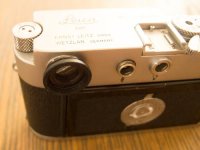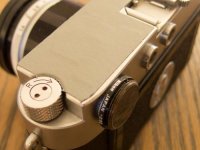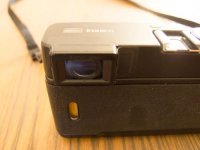Pascal86
Newbie
Hello to all,
First, please excuse my English.
I thought I could contribute to help those who, like me, are desperate to find diopter correction lenses for their rangefinders, and cannot find any for their cameras (or do not want to pay the price for an official leica M diopter lens).
I managed to find a cheap solution for 4 of my cameras: M2, M3, Hexar RF and Canon P.
For my M2 and M3 I used two cheap diopter correction lenses that are widely available (around 20$ each): a Nikon FM diopter lens, and a Fuji X-Pro lens. Both are wider than the M eyepice. So the solution was to cut a O-ring of the shape and width of the M eyepied in a double face black tape (foam tape of a few millimeters) and to stick one face on the M finder and the Nikon and Fuji eyepiece on the other face. For the Nikon I found it easier to put the diopter lens reverse. See photos. For aesthetic reasons and in order to avoid damage on the glass of the diopter lens (?) I inserted a black O ring of black fabric between the adhesive part of the black tape and the diopter glass, leaving enough adhesive surface on the outsides to stich to the right of the diopter eyepiece.
I used these two diopter lenses, but other might be even more practical. So far no problem at all. This is sturdy enough. Of course I might use an official M dipoter when I find one at reasonable price.
Hexar RF is another problem. As you know, it is virtually impossible to find a diopter lens for this camera. Again, I used a diopter correction lens from another camera. I chose the square diopter correction lens for Canon A1 and other FD-mount film SLRs. I lost the package but I think it's alled "dioptric adjustment Lens S". Mine has metal pieces inside. I think other models are all plastic but might fit as well. This correction lens fits over the eyepiece of the hexar so that the inside of the correction lens touches the hexar viewfinder, and the surrounding frame of touches the body of the hexar. In order to secure I used black tape (electric tape?). You can see on my photo that my work in curring the tape was not perfect, but it really is sturdy and comfortable. For me now, this is like a new camera.
Canon P is a bit more tricky. Basically I torn apart (actually, unscrewed) a square canon diopter correction eyepiece (same one used for the Hexar) to take out the sqare diopter correction lens. Then remove the eyepiece from the Canon P (not need to take the top off. Just unscrew). You can then remover the piece of glass inside (glued if I remember correctly). Then just cut the diopter correction glass to the dimensions of the glass in the CANON P viewfinder (easy, just a line with a simple glass cutter knife), and glued it to the frame of the viewfinder in place of the old glass. Then screwed back the eyepiece and voilà. New camera with diopter correction. Of course this can be reversed. I did the same for an old Konica RF.
Hope that helps those who like me have spent hours over the web to find a solution or a diopter lens for these cameras.
If you have other solution or refinements, please share.
Pascal
First, please excuse my English.
I thought I could contribute to help those who, like me, are desperate to find diopter correction lenses for their rangefinders, and cannot find any for their cameras (or do not want to pay the price for an official leica M diopter lens).
I managed to find a cheap solution for 4 of my cameras: M2, M3, Hexar RF and Canon P.
For my M2 and M3 I used two cheap diopter correction lenses that are widely available (around 20$ each): a Nikon FM diopter lens, and a Fuji X-Pro lens. Both are wider than the M eyepice. So the solution was to cut a O-ring of the shape and width of the M eyepied in a double face black tape (foam tape of a few millimeters) and to stick one face on the M finder and the Nikon and Fuji eyepiece on the other face. For the Nikon I found it easier to put the diopter lens reverse. See photos. For aesthetic reasons and in order to avoid damage on the glass of the diopter lens (?) I inserted a black O ring of black fabric between the adhesive part of the black tape and the diopter glass, leaving enough adhesive surface on the outsides to stich to the right of the diopter eyepiece.
I used these two diopter lenses, but other might be even more practical. So far no problem at all. This is sturdy enough. Of course I might use an official M dipoter when I find one at reasonable price.
Hexar RF is another problem. As you know, it is virtually impossible to find a diopter lens for this camera. Again, I used a diopter correction lens from another camera. I chose the square diopter correction lens for Canon A1 and other FD-mount film SLRs. I lost the package but I think it's alled "dioptric adjustment Lens S". Mine has metal pieces inside. I think other models are all plastic but might fit as well. This correction lens fits over the eyepiece of the hexar so that the inside of the correction lens touches the hexar viewfinder, and the surrounding frame of touches the body of the hexar. In order to secure I used black tape (electric tape?). You can see on my photo that my work in curring the tape was not perfect, but it really is sturdy and comfortable. For me now, this is like a new camera.
Canon P is a bit more tricky. Basically I torn apart (actually, unscrewed) a square canon diopter correction eyepiece (same one used for the Hexar) to take out the sqare diopter correction lens. Then remove the eyepiece from the Canon P (not need to take the top off. Just unscrew). You can then remover the piece of glass inside (glued if I remember correctly). Then just cut the diopter correction glass to the dimensions of the glass in the CANON P viewfinder (easy, just a line with a simple glass cutter knife), and glued it to the frame of the viewfinder in place of the old glass. Then screwed back the eyepiece and voilà. New camera with diopter correction. Of course this can be reversed. I did the same for an old Konica RF.
Hope that helps those who like me have spent hours over the web to find a solution or a diopter lens for these cameras.
If you have other solution or refinements, please share.
Pascal




